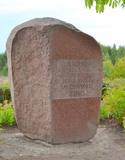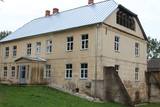| Nr | Name | Beschreibung |
|---|---|---|
|
Natürlich angebaute Heilpflanzen, Abende am Feuer, nach besonders auserwählten Rezepten zubereitetes Essen. Im Bauernhof Energia werden Heilpflanzen angebaut, Waren und Dienstleistungen angeboten, die mit den Heilpflanzen und der positiven Energie verbunden sind. |
||
|
Befindet sich in einer kleinen Ortschaft Vasiļova, am Rande der Landstraße Daugavpils – Rēzekne (A13). Hier befand sich einst ein kleines Landgut Vasiļova und der Mieter des Landguts war der Vater von Jāņis Raiņis – Krišjānis Pliekšāns. |
||
|
Guest house "Aivari" is located in a quiet forest in Inčukalns region. Offers rest in a country sauna, after the sauna it is possible to use a shower, cool off in the pool, also a swim in the spring pond and a wooden tub. There are tent sites, a picnic area with awnings, a volleyball net and several campfire sites. |
||
|
Izcila lokveida taka (4,5 km), kuras lielākā daļa (koka laipas) ved pa Rīsas purvu (Riisa raba). No takas un divstāvīgā koka skatu torņa ir vērojami purva ezeriņi, lāmas, un purvaini meži. Ja nacionālā parka apskati sāk no ziemeļu puses, tad šī taka ir labs ceļojuma iesākums! |
||
|
Meistardarbnīcā „Cimdiņi” darbojas Latvijas Amatniecības kameras diplomētā meistare Ina Valtere, pie kuras ikvienam ir iespēja uzzināt visu interesējošo par rokdarbiem, kā arī iegūt padomu un ieteikumus adīšanā, izšūšanā un tamborēšanā. Tiek piedāvāta iespēja piedalīties arī darbnīcās un meistarklasēs. |
||
|
The Vijciems Hunting Castle building houses an elegant design guest house Bergervilla. Each room has an individually designed design, historic furniture and a special atmosphere. There are 4 rooms available - a standard room, a two-room suite and two deluxe rooms with a private balcony and a bathtub. Each room is given the name of a forest beast or bird - Owl, Mednis, Deer and Elk. There is also a living room and library for guests to relax in, as well as a fully equipped kitchen for cooking. Free Wi-Fi and parking are available. |
||
|
Со стороны шоссе Рига – Даугавпилс (А6) (напротив кафе «Бордертаун») стоит необычный (построенный из складывающихся конструкций) храм, который изготовлен в Одессе в 1866 году. Церковь служила передвижной церковью царской армии и стоит на этом месте с 1904 года. Раньше (с 1886 г.) она находилась в Даугавпилсе. При храме построен деревянный дом-молельня, который открыт целые сутки. |
||
|
Die erste Molkerei von Malpils wurde 1923 gegründet. Dort wurde Butter und Käse hergestellt. In den 70-en Jahren des vorigen Jahrhunderts wurde hier angefangen, den ersten weichen Frischkäse in Lettland „Mālpils” herzustellen. Eine vorherige Vereinbarung ist notwendig für eine Betriebsbesichtigung mit der Verkostung der Erzeugnisse. Käsespezialitäten kann man vor Ort kaufen – im Lebensmittellager. |
||
|
This is Lithuania’s largest mossy swamp, and the Čepkeliu Nature Reserve was established to protect it. Before visiting the swamp, you must register at the Dzūkijos National Park’s visitor centre (Marcinkonys, Šilagėlių gatve 11). |
||
|
Wenn man auf der Straße Nereta – Ilūkste fährt, kann man das Gotteshaus schon von weitem sehen. Es ist im Jahr 1805 gebaut, aber im Jahr 1888 restauriert worden. In der Kirche haben sich der ursprüngliche Altar, die Kanzel und der Orgelprospekt erhalten. An der Kirche sind die im Ersten Weltkrieg gefallenen deutschen Soldaten bestattet worden. An der westlichen Gebäudewand befinden sich zwei Gedenktafeln, die zu Ehren der im Ersten Weltkrieg gefallenen Einwohner der Gemeinde Laši und der während der Sowjetzeit Repressierten enthüllt sind. |
||
|
The historical centre of Talsi, which is known as the town of nine hillocks. The historical construction around Baznīckalns hill, Lake Talsi and Lake Vilkmuiža mostly dates back to the 19th century. Lielā Street is particularly beautiful with its low-rise buildings (two or three floors and ridged roofs). There are beautiful views from the area around Lake Talsi and Ķēniņkalns hill. |
||
|
Muižas dzīvojamā ēka līdz mūsdienām nav saglabājusies. Šodien Dvietes muižas parkā ir apskatāmas muižas pārvaldnieka māja un trīs mūra saimniecības ēkas. 19. gs. veidots ainavu parks ar laukakmeņu mūrējuma tiltu. Parkā atrodas Dvietes muižas ēkas. |
||
|
Wie haben unsere Vorfahren vor 1000 Jahren gelebt? Wie waren sie gekleidet, welche Werkzeuge und Gebrauchsgüter haben sie benutzt? Antworten auf diese Fragen bekommen Sie auf Wikingerfestival, die traditionell jährlich im Juli in Kiruvere stattfindet und wo sich die Fans aus Estland, Lettland, Litauen und Finnland treffen. |
||
|
This company uses natural juices and other raw materials to produce blackberry, black currant, sea buckthorn and spinach glazes that are used to decorate handmade gingerbread. You can listen to stories, take part in thematic activities, bake your own gingerbread, and buy dough and finished cookies. |
||
|
Saimniecības pamatnodarbošanās ir diļļu audzēšana un to pārstrāde. Siltumnīcā audzē arī Itālijas dienvidos zināmu melones un gurķa krustojumu "Carosello", kas latviski nodēvēts par "pūkaino gurķi". Iespējamas degustācijas, kā arī saimniecības produkcijas iegāde. |
||
|
The farm has a fabulous apple orchard and also grows potatoes and strawberries. You can buy apples and taste strawberries. |
||
|
Divstāvīgā ēka ir redzama no Dundagas – Ģipkas ceļa (ap 3,7 km no Ģipkas ciema). Šis nav tūrisma objekts, bet gan vēsturiska vieta, kurai vērts pievērst uzmanību kaut vai no attāluma. Ēkas pirmajā stāvā no 1860. g. darbojās skola, kurā par skolotāju strādāja rakstnieks Antons Austriņš. 1867. g. tai uzbūvēja otro stāvu, kurā uzsāka jūrskolas izveidi. Jūrskola darbojās līdz 1894. g., kad to pārcēla uz Mazirbi. |
||
|
Ein Familienunternehmen, das sich mit der Herstellung von kulinarischen Köstlichkeiten und Süßwaren in der Gemeinde Jaunannas der Region Alūksne beschäftigt. Leckere Fleischrouladen, die nach Großmutter-Rezepten zubereitet werden, und sonstige Fleischwaren in großer Auswahl sowie spezielle Süßwaren aus der Konditorei Gustiņš kann man im Geschmacksladen Gustiņs in Alūksne kaufen. Man kann köstliches und leckeres wie hausgemachtes Essen und für die Region Alūksne typische „malenische“ Gerichte (nach vorheriger Anmeldung) im Café Gustiņš genießen. |
||
|
Befindet sich nahe der Mittelschule von Rūjiena. Die vom Bildhauer Kārļis Zemdega errichtete Skulptur „Madonna Orans” wurde 1936 zum Andenken an die ertrunkene Lehrerin der Gemeindeschule Jūlija Skujiņa (24 Jahre alt) aufgestellt. Es gibt verschiedene Legenden über die Anlässe des Todes. Eine der Legenden ist mit einer unglücklichen Liebe zum Pastor Roberts Slokenbergs verbunden. |
||
|
Boutique Hotel Altenburg mājo vairāk nekā divus gadsimtus senā koka ēkā, kas ir viena no ievērojamākajām Talsu vecpilsētas arhitektūras pērlēm. Kādreiz gandrīz pamesta un nolaista, šī ēka piedzīvojusi rūpīgu restaurāciju, atgūstot savu šarmu un vēsturisko stāju. Viesnīcas interjers ir harmonisks līdzsvars starp wabi-sabi pieeju, rustikālu eleganci un dabiskām faktūrām — te dominē koks, akmens un lins. Katrā telpas detaļā jūtama pārdomāta izvēle un cilvēciska piesaiste. Dizaina koncepciju radījis Roalds Cinis, bet apdari papildina vietējo meistaru roku darbs: “Ciparnīcas” keramikas trauki, darināti pledi un Latvijas tējas. Viesiem piedāvāti seši divvietīgi numuri, koplietošanas virtuve un mājīgs salons, kā arī klusas lasīšanas vietas ar grāmatām un mazs vīna pagrabiņš. Boutique Hotel Altenburg atspoguļo lēnās dzīves filozofiju — tā ir vieta nesteidzīgai atpūtai, klusumam un pievēršanās sev. |
||























